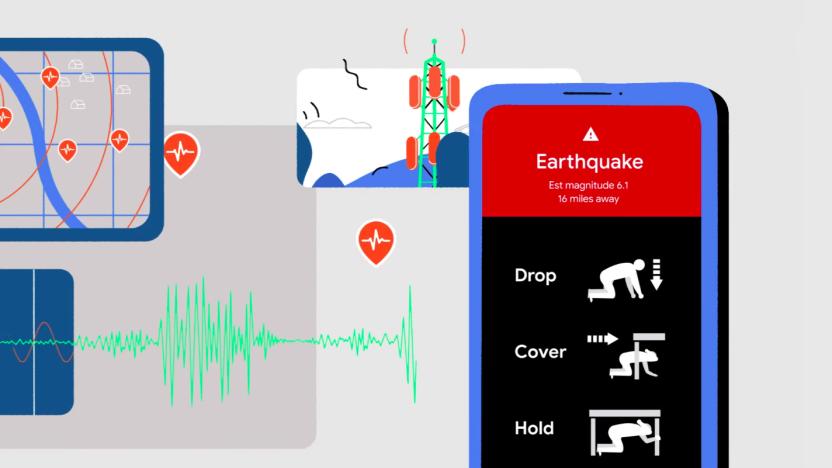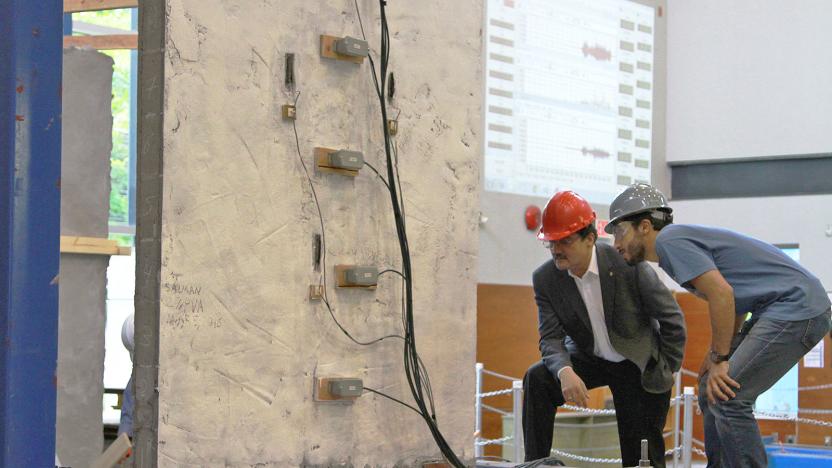earthquakes
Latest

Android earthquake alerts are now live in Greece and New Zealand
Google is rolling out its Android earthquake detection feature in New Zealand and Greece after launching the system in parts of the US.

Google turns Android phones into an earthquake detection network
“Your Android phone can turn into a mini seismometer, joining millions of other Android phones out there to form the world’s largest earthquake detection network,” Stogaitis said. Google will use your phone’s accelerometer to detect the movement. Google had more to share today.

Eco-friendly concrete protects old buildings from earthquakes
Concrete has become the high-rise building material of choice because it's relatively cheap, easy to work with, long-lasting, and highly resistant to fire or explosions, unlike steel. It does have one inherent flaw, though: It's not great under tensile loads, so it requires heavy steel reinforcement to resist earthquakes. However, researchers from the University of British Columbia (UBC) have developed a new type of concrete with steel-like properties that can resist powerful quakes and is eco-friendly, to boot.

How seismographs can track battlefield bombings
A team of researchers from Washington University in St. Louis, led by Ghassan Aleqabi, recently stumbled upon a treasure trove of seismic data from a most unexpected source: an array of earthquake monitors installed in Iraq and originally used to keep tabs on Iran's nuclear tests. They also allow Iraqi universities to study small scale 'quakes. The 10 seismic monitoring stations were initially installed by the US, with Aleqabi's assistance, in 2005.

NASA READIs early detection GPS network, aids first responders with earthquake warnings
After tacking space shuttle Discovery onto the back of a 747, the brainy gang over at NASA's READI for a new challenge -- earthquake detection. The agency's GPS-monitoring system, known as the Real-time Earthquake Analysis for Disaster Mitigation Network, is being tested with the goal of more accurately detecting the scale of quakes and, consequently, getting tsunami warnings out as soon as possible. The setup, made possible by a partnership between the Department of Defense, the National Science Foundation, and the United States Geological Survey, works by measuring ground displacement in real-time to provide a faster, more detailed assessment of imminent damage, thereby giving first responders a head start on determining aid. So the next time you look up to the night sky and wish upon a tracking star, keep in mind that sometimes privacy-skewing, positioning tech could just save your life.

University gets $188 million AMD-based supercomputer, free copy of Norton
It used to be that you only needed a bachelor's degree and elbow patches to be taken seriously as an academic, but now it's all about that 50-petaflop supercomputer with 500 petabytes of storage whirring away in the basement. The University of Illinois used to shop with IBM, but it's just about to have a brand new Cray XK6 installed instead, so it can continue providing computing power to the National Science Foundation's Blue Waters project. It's not all about inciting gadget envy, of course: the machine's unlikely truce of AMD Opteron 6200 16-core processors and NVIDIA Tesla GPUs will help more than 25 teams of scientists to model and understand real-world phenomena, from the damage caused by earthquakes to the way viruses to break into cells. Breakthroughs from these projects will -- hopefully, one day -- make the $188 million total cost of Cray's products and services seem like a bargain. Full details in the PR after the break.

Earthquake detection software gains foothold in California
Stanford's Quake-Catcher Network has been up and running since early 2008, but it looks like it's just now starting to reach the critical mass of users that's essential for its success. As you may be aware, the software takes advantage of the accelerometers built into many new laptops to watch for any signs of shaking or vibration, which it then compares with data from other laptops in the same area -- if they're all shaking at the same time, that's a pretty good indication there's an earthquake happening. Until recently, however, there hasn't been enough users in any particular area to produce reliable data, but Stanford now counts more than 450 users in California alone, which has provided it with its first truly viable testbed. Of course, more users would be even better, and you can sign up and download the software at the link below if you're interested in helping out.

Blizzard's comments on the in-game Cataclysm earthquakes
Blue posters in the official forums have started leaving comments about the earthquakes happening in-game, which as we reported the other day, appear to be linked to in-game mobs that are potentially ushering in the beginning of the Cataclysm world event. The comments are somewhat cryptic, but that is par for the course with Blizzard. They like to tease -- to hold the carrot in front of you and make you run for it. But the evidence we presented Monday was pretty solid, and it's gained even more traction in the community and around the net; so this is an interesting follow up to it all. The comments thus far after the break.

Research shows live bacteria can lessen earthquake damage
Bacteria aren't lookin' too shabby these days, aiding in digestive health and even moonlighting as a fuel source. Recent studies also show that the use of live bacteria could very well solidify deep, sandy soils that make for treacherous grounds when an earthquake strikes. The new findings hint at a promising alternative to the use of bonding epoxy chemicals, which can boost toxicity levels in soil and water. The mighty microbe, Bacillus pasteurii to be exact, essentially transforms loose sand back into sandstone by depositing calcite (calcium carbonate) throughout the grains, fusing them together. Buildings sitting atop soils treated with the bacteria are predicted to experience considerably less devastation than those on the loose soil that tends to liquefy beneath them in the event of a quake, typically resulting in collapse. The research, partially being developed at UC Davis, is restricted to the lab at the moment, however plans to scale up are on the table. So the next time all you coast-dwellers fall violently ill from some ratfink bacteria, remember that his cousin might save your apartment, or even one day, your life.[Thanks, Sid]






